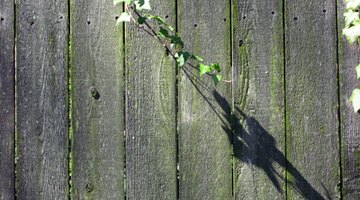The Best Wood for Fences
The best wood fences are made of naturally rot-resistant and pest-resistant lumber. While many home improvement stores offer inexpensive fir and hemlock fence boards, the higher initial cost of a more durable species pays off in both appearance and longevity. The principle of "you get what you pay for"

applies to fence rails and posts as well. Your fence will perform at its best when boards, rails and posts are all composed of high-quality lumber.
Redwood Heartwood
The attractive natural hues of redwood range from whitish-pink to a rich brown-red, but redwood's heartwood is a deep red color. The term "heartwood" refers to the hard, innermost flesh of a tree, as opposed to the young, outermost "sapwood." Heart redwood contains substantial amounts of tannic acid, a naturally occurring compound that provides the tree with near immunity to rot and pest damage. If you purchase redwood posts, rails or boards for fencing, make sure that the lumber is "all heart." Although all-heart redwood is expensive, redwood that contains excessive sapwood offers little decay resistance.
Red Cedar
Like redwood, cedar brings both natural beauty and durability to a fencing project. Although building material suppliers market several species of cedar, many builders consider western red cedar the premier species for its deep clay-red hues and natural durability. Naturally occurring compounds called tropolones provide cedar species with rot resistance and pest resistance. Significant tropolone content occurs only in the heartwood portion of the cedar tree. Due to a relative abundance of supply, all-heart cedar is generally less expensive than all-heart redwood.
Tropical Hardwoods
Typically reserved for interior, finish-grade projects, hardwoods are exceptionally attractive but quite costly. The hardwoods suitable for exterior fencing are the same materials used for shipbuilding and outdoor furniture. Although most mahogany species appear prohibitively expensive, builders often use them for exposed features such gates and decorative accents. Alternatively, the rot resistance and pest resistance of tropical hardwoods often matches that of redwood, cedar or mahogany. Tropical hardwoods, such as ironwood, are generally less expensive than traditional hardwoods, such as mahogany.
Building For Longevity
Regardless of wood species, careful construction practices and regular maintenance can substantially increase a wood fence's lifespan. Burying fence posts in the soil or concrete provides lateral stability critical to many fence installations, but buried portions of posts are prone to rotting, presenting a tradeoff. Using special post brackets -- either buried in concrete or driven into the ground -- helps protect the posts; however, brackets are not suitable for all fence applications due to limited lateral stability and other factors. To improve the longevity of the overall fence structure, fencing fasteners, such as nails and screws, must be corrosion-resistant. Corrosion-resistant fasteners include galvanized fasteners and stainless steel fasteners.
The Drip Cap
- The best wood fences are made of naturally rot-resistant and pest-resistant lumber.
- Although building material suppliers market several species of cedar, many builders consider western red cedar the premier species for its deep clay-red hues and natural durability.
- The hardwoods suitable for exterior fencing are the same materials used for shipbuilding and outdoor furniture.
- Burying fence posts in the soil or concrete provides lateral stability critical to many fence installations, but buried portions of posts are prone to rotting, presenting a tradeoff.
- Corrosion-resistant fasteners include galvanized fasteners and stainless steel fasteners.
References
Writer Bio
Based in Hawaii, Shane Grey began writing professionally in 2004. He draws on his construction experience to write instructional home and garden articles. In addition to freelance work, Grey has held a position as an in-house copywriter for an online retailer. He holds a Bachelor of Arts in theater arts from Humboldt State University.
Photo Credits
- ivy through wooden fence image by Allen Penton from Fotolia.com
- ivy through wooden fence image by Allen Penton from Fotolia.com
More Articles



